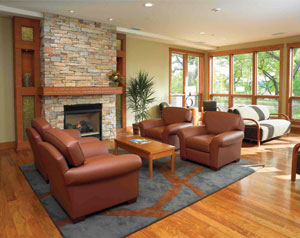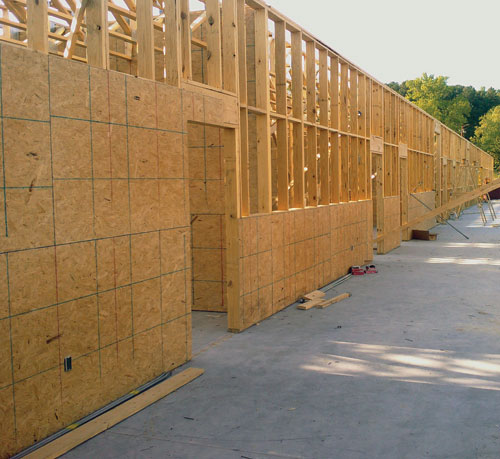A Natural Choice
 |
The design and construction team used natural cedar and stained wood to create warmth both inside and out. Photo courtesy of TWP Architecture. © Tom Davenport |
Wood's ability to create warmth and provide an enriching environment is also cited as a reason for its use in many schools. In a three-year study of 700 schools, Japanese researchers examined how the educational environment is influenced by a school's building materials. Data found reduced flu outbreaks in wood-framed schools compared to concrete facilities. Another Japanese study measured the impression of teachers and students concerning wood versus reinforced concrete. Both groups reported favorable impressions of wood schools, with teachers and students in wood schools feeling less fatigue.15
Another study, this time in Austria, found that interior wood use in classrooms reduced pupils’ stress levels, as indicated by criteria that included heart rate and perceived stress from interaction with teachers.16
Wood and Economic Considerations
Wood products offer advantages in terms of cost. As a material grown throughout North America, they can be locally sourced and are usually less expensive than alternative building materials. Wood building systems typically cost less to install than other materials. Whether comprised of traditional wood framing, panelized products or prefabricated assemblies, wood construction is fast, expediting project completion. Wood's relative light weight reduces the need for foundation capacity and associated costs. Further, most communities have a large pool of qualified tradespeople with wood framing experience, which minimizes construction delays and keeps labor costs competitive.
Anecdotal evidence points to wood's cost advantage in many applications. Speed and ease of construction are generally considered to be key benefits of wood-frame buildings, attributes that help meet occupancy deadlines and directly impact budgets. For example, by using wood for the 320,000-square-foot El Dorado High School in Arkansas, the project team saved an estimated $2.7 million as compared to a similar masonry and steel building. "Integrating wood throughout the school proved to be an economical option," says project architect Blake Dunn of CADM Architecture. Similarly, the Fountain Lake School District of Hot Springs, Arkansas, saved $2.7 million on a 63,000-square-foot project that included a new middle school and high school renovation by switching to wood from the original masonry and steel design. "Wood works particularly well when a project has a tight construction schedule," says Mark Batten, SE, with Burkett & Wong Engineers in San Diego. "Contractors can get started right away without waiting for steel shop drawings or steel fabrication. When we design a wood-framed school, we do so primarily because of cost, schedule, and ease of construction."
 |
Fountain Lake School saved time and money by specifying wood as a structural building material. |
Wood's cost effectiveness isn't limited to schools. TWP Architecture's Curran, says of the Herrington Recovery Center, "Certainly from a cost standpoint, it made a lot of sense to do the whole thing on a wood frame." In Seattle, architects used a wood-frame podium to financial advantage in the Marselle Condominiums, a 160,000-square-foot structure that includes five and one-half stories of wood over a two-story concrete podium deck. Though the condos achieved local environmental certification, the decision to use wood framing was purely financial, according to Kory Knudson, Vice President of Norcon, NW, Inc. "If the project had been built using all concrete, for instance, it would have cost about 30 percent more. If we had built the entire project out of steel, it would have taken much longer and we would have had to make many energy modifications."









